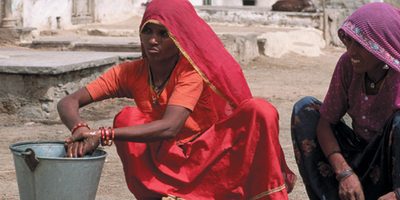
Visions of a healthier India
Nestled deep in the rural heartland of Indian’s south-eastern coast lies the small village of Garagaparru in Andhra Pradesh. The village has been home to generations of Indians that have laboured on the land farming rice, sugar cane, corn and countless other foods that gave birth to its moniker as the ‘rice bowl of India’.
Even after the tide of industrialisation gave birth to the urban landscapes of Hyderabad and the giant costal port of Visakhapatnam, Garagaparru retained its rural landscapes and heritage. Today villagers continue to work the land as they have always done.
Dhana Lakashmi was born in Garagaparru village and after completing her schooling was driven by a passion to contribute to her community by becoming a multi-purpose health worker.
“I joined The Byrraju Foundation which is a not-for-profit organisation that promotes healthcare, education, and health in remote villages including our village. At that time, The George Institute and The Byrraju Foundation started the Andhra Pradesh Rural Health Initiative (APRHI) study.”
The APRHI study was carried out in collaboration with the Centre for Chronic Disease Control, Hyderabad’s CARE Foundation, The George Institute and The University of Queensland. It aimed to understand the main causes of morbidity and mortality throughout the East and West Godavari districts of Andhra Pradesh. This evidence from this study has now been used to train health workers like Dhana Lakashmi to improve the lives of people living throughout the region.
“Because of the study, it has been discovered that more villagers are dying with cardiovascular diseases and injuries than it was thought. Before the study, many people used to think that heart attack and injuries were more common for people living in cities and towns. The study proved otherwise.”
“We collected blood samples and conducted house-to-house surveys as part of the study. We diagnosed high-blood pressure and diabetes in many people and asked them to come to health centres and collect medicines. We also gave dietary advice that educated people about best to avoid high blood pressure, diabetes, stroke and obesity.”
“Many people, many of them my friends, changed their lifestyles and eating habits. They started using good quality refined oils, even if it did cost more, and they stopped adding salt to buttermilk and their food.”
“By working with The George Institute on the APRHI study, we showed that the delivery of health care in rural India need not be very expensive. People lives can be improved by involving the local health care providers more actively and by implementing simple strategies like the identification of high-risk individuals, secondary and non-drug prevention strategies.”
“I know that the study made the government and other organisations stand up and focus on the rural population. Encouragement and hard work by the health workers go a long way in solving the majority of health problems in rural areas.”


